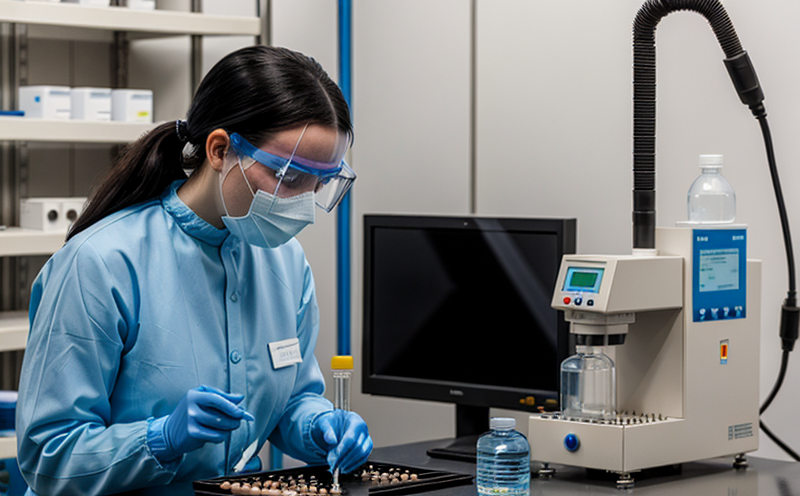SEC HPLC Aggregate Profiling Testing
The SEC (Size Exclusion Chromatography) coupled with HPLC (High Performance Liquid Chromatography), also known as SEC-HPLC, is a critical analytical technique used in pharmaceutical testing to assess the aggregate profile of biopharmaceuticals. This method is particularly important for ensuring product quality and safety by quantifying aggregates such as dimers, trimers, and higher-order oligomeric forms that can impact drug efficacy and stability.
SEC-HPLC works on the principle that different-sized molecules will elute from the column at different times based on their size. Larger molecules travel more slowly through the column than smaller ones due to steric hindrance and entanglement, which results in a distinct separation of aggregates from monomeric species. This technique is widely used for quality control and stability studies of biologics like monoclonal antibodies (mAbs), fusion proteins, and therapeutic peptides.
Preparation of samples for SEC-HPLC involves dilution with appropriate buffer systems to ensure compatibility with the column matrix without altering the sample’s native structure. The sample is then filtered through a 0.2 μm filter to remove particles that could interfere with the chromatographic process. This step ensures accuracy and reproducibility in the analysis.
The instrumentation used for SEC-HPLC includes high-pressure pumps, degassers, autosamplers, columns, and detectors such as UV/Vis or refractive index (RI) detectors. The column is typically packed with porous beads designed to separate molecules based on their size, with a narrow pore diameter that allows only smaller molecules through.
For accurate quantification of aggregates, it’s essential to establish the limits of detection and quantitation for each aggregate type within the biopharmaceutical product. This involves calibration using standards prepared at known concentrations and running these alongside test samples during analysis. The results are reported as weight percentages or fractions based on peak areas obtained from the chromatogram.
Compliance with international standards such as ISO, ASTM, and Pharmacopeial Convention is crucial. For instance, ISO 14685:2007 provides guidelines for biopharmaceutical testing, while USP United States Pharmacopoeia chapters like Q2 (R1) cover the aspects of aggregate profiling. These standards ensure that the testing methods used are robust and reliable.
| Applied Standards | Description |
|---|---|
| ISO 14685:2007 | Guidelines for biopharmaceutical testing |
| USP United States Pharmacopoeia Q2 (R1) | Aggregate profiling in drug product development |
Competitive Advantage and Market Impact
The ability to accurately profile aggregates through SEC-HPLC provides a significant competitive edge in the pharmaceutical industry. By ensuring consistent quality, manufacturers can prevent potential issues such as immunogenicity associated with unwanted aggregates in biopharmaceuticals. This ensures patient safety and enhances product efficacy.
Compliance with stringent regulatory requirements is crucial for maintaining market access and reputation. SEC-HPLC aggregate profiling not only aids in meeting these standards but also helps pharmaceutical companies stay ahead of evolving industry expectations. By adopting advanced analytical techniques like this, organizations can differentiate themselves through superior quality offerings.
The increasing focus on personalized medicine and the growing demand for complex biopharmaceuticals underscore the importance of robust testing methodologies such as SEC-HPLC aggregate profiling. It plays a pivotal role in supporting innovation by providing critical data that informs formulation development and process optimization.
Use Cases and Application Examples
- Quality Control: Routine monitoring of biopharmaceutical products to ensure they meet quality standards set out by regulatory bodies.
- Process Development: Optimization of manufacturing processes through the identification of process-related impurities that can affect product stability and performance.
- Stability Studies: Evaluation of how a drug behaves over time under various storage conditions to predict its shelf life.
- Biocompatibility Testing: Assessment of potential interactions between the biopharmaceutical and biological systems, which is essential for ensuring safety in clinical applications.
| Use Cases and Application Examples | Description |
|---|---|
| Routine Monitoring | Maintaining consistent product quality through regular testing. |
| Process Optimization | Detecting impurities that could impact the final product. |
| Stability Evaluation | Predicting shelf life and storage conditions for optimal performance. |
| Biocompatibility Assessment | Evaluating safety in biological systems before clinical use. |





